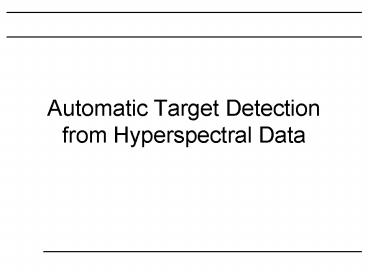Automatic Target Detection from Hyperspectral Data PowerPoint PPT Presentation
1 / 10
Title: Automatic Target Detection from Hyperspectral Data
1
Automatic Target Detection from Hyperspectral Data
2
Objectives and Work Activities
- Objectives
- Develop an automated framework for hyperspectral
target detection subject to environmental
variability - Lower the probability of false alarms
- Work Activities
- Trade Studies and Assessment
- Data Processing Analysis
- Algorithm Validation and Evaluation
3
Past Accomplishments
- Trade studies of spectral/spatial binning and
their effect on detection results for a variety
of target materials - Processed data from several different
collections, i.e., HYDICE Forest Radiance, AURORA
at Aberdeen proving grounds, Hawaii coral
mapping, drug interdiction, and submarine
detection. - Several detection algorithms were developed and
compared -- Linear unmixing, CEM, OSP, RX, and
PCA - Several spectral comparison methods were
evaluated, such as spectral fingerprinting, SAM,
clustering. Simple atmospheric correction and
de-shadowing techniques were tested. MODTRAN was
run on several minerals to evaluate atmospheric
variance.
4
Spatially Binned HYDICE Forest Radiance Subset
No Spatial Binning
4x4 Spatial Binning
8x8 Spatial Binning
16x16 Spatial Binning
5
ATR Procedure
Alarmed pixels
Classes
Target list with scores
6
ATR and Linear Unmixing
- Unmixing method projects spectral data into
feature space, classifying each pixel by
membership in endmember class - Each class is sorted into either a background
class (soil, foliage, water) or anomaly class - First step of ATR identifies likely target
pixels by degree of membership in anomaly class - Next (optional) step identifies likely target
pixels by similarity to spectra in library of
targets (Bloodhounds). Similarity metrics
include SAM and spectral fingerprints. - Similarity metric must be robust to
atmospheric/environmental changes between data
collects - Finally, contiguous target pixels are collected
into objects and spatially filtered. Filters are
upper and lower bounds on length, width, and
aspect ratio
7
Bloodhound Detection of Unique Spectra Under
Different Atmospheric Conditions Using Spectral
Fingerprinting and SAM
Run 1 -- Bloodhound collected
Run 2 -- Bloodhounds detected
Run 2 -- Zoom on subdivision
8
Bloodhound Demonstration - APG
Run 1 -- Bloodhound collected
Run 2 -- Anomalies detected
Run 2 -- Bloodhounds detected
9
Impact on ATR technology
- Goal is the development and improvement of
real-time, operational hyperspectral systems - Spatial/spectral binning trade study shows much
stronger degradation with spatial binning - Several detection algorithms under study --
Linear Unmixing, CEM, OSP, RX, PCA. - Bloodhound comparison methods being developed
-- spectral fingerprinting and SAM. Robustness
of algorithms is being improved using simple
atmospheric modeling, de-shadowing. - Bloodhounds are a key technology for previous
drug interdiction, sub detection, TUT
collections, and for PREDATOR UAV hyperspectral
system
10
Future Plans
- Continue further evaluations and refinements of
detection methods - Enhance algorithm discrimination with
clustering - Improve bloodhound methods using more
intelligent target feature extraction and
pattern comparison - Optimize robustness of endmember selection
process

